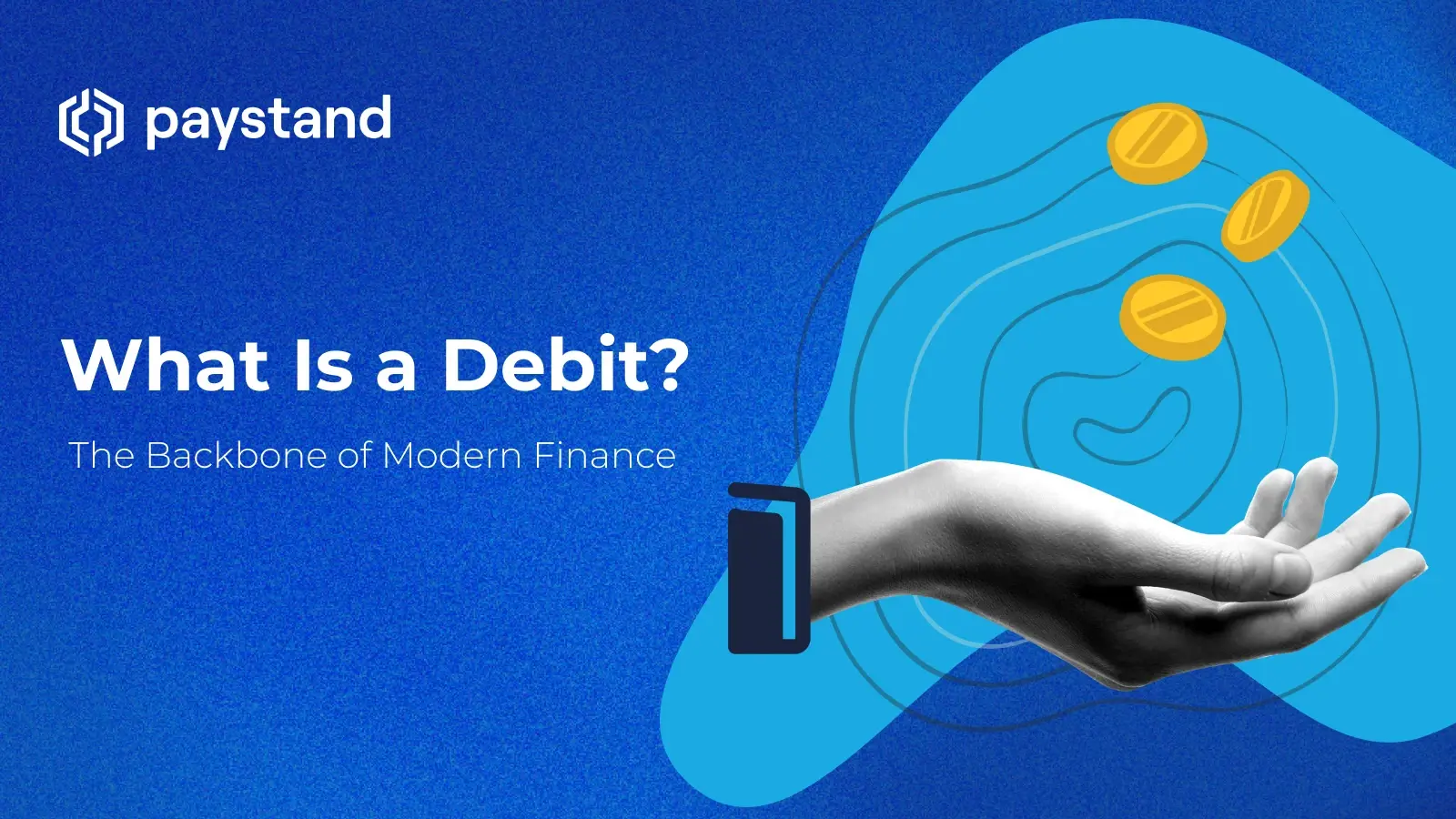What Is a Debit? The Backbone of Modern Finance

Table of Contents
- What is a debit?
- What is the difference between debit and credit?
- How are debits used in bookkeeping?
- How does a debit transaction work?
- What is a debit card?
- What are the pros and cons of debit cards?
- How Paystand redefines the rules
Key Takeaways
- Debits are a key part of accounting that increase assets or expenses, essential for balancing books in the double-entry system.
- Debits, often misunderstood as simply “money going out," are crucial for accurate financial reporting, affecting personal banking and enterprise accounting.
In business finance, debits are essential for managing budgets, refunds, and asset purchases. They appear in journal entries, debit notes, and expense management.
In today's digital finance world, "debit" is crucial. More than a transaction type, it is a cornerstone concept impacting financial operations, from personal banking and business accounting to how finance teams report success. Whether an AR manager reviews journal entries, a controller analyzes cash accounts, or a consumer swipes a card, this movement powers the entire system.
Despite its omnipresence, the term is often misunderstood or oversimplified. Ask someone outside accounting, and you’ll likely hear, “Isn’t it just money leaving your bank account?” The answer depends on which side of the ledger you're on. In a credit-obsessed world, it’s time to give debits the recognition they deserve.
What Is a Debit?
A debit is an accounting entry that typically increases asset or expense accounts and decreases liability, equity, or revenue accounts. It’s often associated with money flowing from an account, but that’s only half the story.
In double-entry accounting, every debit has a corresponding credit, ensuring accurate and symmetrical balances. These are recorded on the left side of the ledger, which is essential for tracking assets and expenditures, and is a critical factor for assessing an organization’s financial health.
What Are Debit Notes?
Debit notes are a staple of business-to-business finance. Mistakes and returns are inevitable when companies engage in recurring or large-scale transactions. They formally acknowledge that money is owed due to a return, overcharge, or other adjustment.
What Is a Dangling Debit?
Dangling debt is a red flag in accounting, occurring when a debit has no matching credit. This typically happens when a company buys intangible assets like goodwill or due to human error in the ledger. In financial reporting, anomalies must be resolved or written off. Unresolved issues distort the balance sheet and mislead stakeholders.
What Is Margin Debit?
In this arrangement, investors borrow funds from a brokerage to purchase more securities than possible with their own money. The borrowed amount becomes a debit balance in their account, reflecting the net owed to the brokerage after considering short sales or credits. They pose financial risks, so regulators monitor them closely. Proper management is essential to avoid sudden margin calls.
What Is the Difference Between Debit and Credit?
In simple terms, a debit increases assets and expenses, while a credit increases liabilities and equity. Think of it like two sides of a scale: when one goes up, the other balances it out. For example, when you provide an employee with a debit card and credit card, you offer two distinct financial tools: one pulls from existing funds, and the other borrows against future repayment.
While debit increases ownership or usage of resources, credits reflect obligations or ownership transferred away. This duality is what gives accounting its structure and trustworthiness. For personal or business finances, the distinction between debit and credit isn’t just theoretical; it has real consequences for how your financial statements tell your story.
How Are Debits Used in Bookkeeping?
In journal entries, debits signify financial change. They record shifts like increasing an asset or decreasing a liability. For example, when your business pays an invoice, your cash account decreases (credit) while accounts payable also decrease (debit).
This system allows finance teams to maintain control and visibility over complex financial ecosystems. Without the rigorous checks of double-entry accounting, misreporting or losing track of funds would be too easy.
How Does a Debit Transaction Work?
When you use a debit card at a point of sale, the merchant’s system sends a request to your bank. If funds are available, the bank approves the transaction and deducts the amount from your cash account. Simultaneously, the merchant’s account is credited with the same amount. It's an instant, behind-the-scenes accounting transaction that keeps everything in balance.
For businesses, every transaction should be mapped to a journal entry, tying purchases directly to budget categories like a specific expense account. That’s how finance teams maintain control, audit readiness, and transparency.
What Is a Debit Card?
A debit card is a payment tool linked directly to a bank account. When used for a purchase or ATM withdrawal, it instantly draws from the available balance; no borrowing, no interest, just real-time payment. That’s why budget-conscious consumers and businesses that want to stay debt-free often prefer these cards.
Unlike credit cards, which require minimum payments, carry interest, and impact your credit history, these cards reflect real-time, grounded spending. You can only spend what you have unless your bank allows overdrafts.
What Are the Fees Associated with Debit Cards?
While debit cards generally have fewer costs than credit cards, they aren’t always fee-free. Some banks charge for overdrafts, foreign transactions, or ATM usage outside the network. In business settings, these small costs can add up quickly, especially if employees use these cards for travel, subscriptions, or recurring payments.
What Are the Pros and Cons of Debit Cards?
Why do some people choose a debit over a credit? The answer lies in simplicity and control: they are a natural fit for companies prioritizing real-time budget enforcement and low-risk spending, especially with platforms offering smart controls and visibility.
| Pros | Cons |
|---|---|
| No debt accumulation | No credit-building benefits |
| Immediate reflection of expenses | Overdraft risks if not monitored |
| Simple to manage | Limited fraud protection compared to credit cards |
| Often fewer fees than credit cards | Spending caps tied to available balance |
Debits are used for more than just swiping at checkout. In business, they’re part of everything from issuing refunds and adjusting invoices to purchasing assets and tracking spending. Anytime you reduce a liabilities account or increase an asset account, you’re making a debit entry.
From purchasing office equipment to managing software subscriptions, understanding when a debit is used gives financial leaders clarity and confidence in their systems.
How Paystand Redefines the Rules
Here’s the big picture: While debits may seem like an old-school accounting concept, they’re at the heart of modern financial operations. Understanding them is crucial whether you're managing digital payments, reviewing your financial statements, or auditing your expense account.
But here's the catch: legacy systems haven’t evolved as fast as today’s financial demands. Manual entries, transaction fees, and opaque approval workflows create bottlenecks.
That’s where Paystand flips the script. With blockchain-based smart contracts, zero-fee processing, and real-time visibility into your accounting balances, Paystand turns the debit into a dynamic, intelligent action, not just a passive record.
In the cryptocurrency, automation, and decentralization age, debits don’t need to be boring. With Paystand, they become part of a larger financial revolution that empowers finance teams to move faster, smarter, and more securely.
Ready to stop reconciling yesterday’s numbers and start building tomorrow’s finance? Paystand is here to help you move forward.






